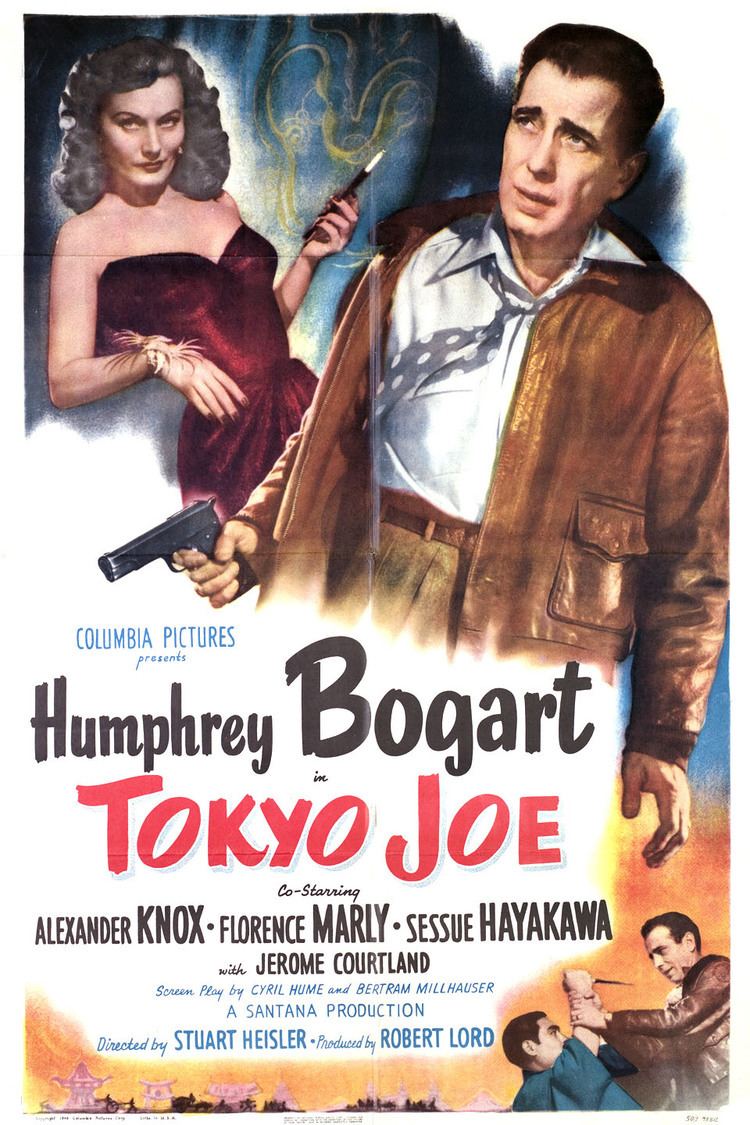6.8 /10 1 Votes6.8
80% Rotten Tomatoes Music director George Antheil | 6.4/10 IMDb 3/5 The Film Yap Initial release 1949 Screenplay Steve Fisher Producer Robert Lord | |||||||||||||||||||||||||||||||||
 | ||||||||||||||||||||||||||||||||||
Written by Steve FisherWalter Doniger Starring Humphrey BogartAlexander KnoxFlorence MarlySessue Hayakawa Cast Similar Humphrey Bogart movies, World War II movies, Movies about marriage | ||||||||||||||||||||||||||||||||||
Tokyo joe trailer
Tokyo Joe is a 1949 American film noir crime film directed by Stuart Heisler from a story by Steve Fisher, adapted by Walter Doniger and starring Humphrey Bogart, Alexander Knox, Florence Marly, and Sessue Hayakawa. This was Heisler's first of two features starring Bogart, the other was Chain Lightning that also wrapped in 1949 but was held up in release until 1950.
Contents
Tokyo joe 1949 humphrey bogart clip
Plot
After World War II, ex-serviceman Joe Barrett (Humphrey Bogart) returns to Tokyo to see if there is anything left of his pre-war bar and gambling joint ("Tokyo Joe's") after all the bombing. Amazingly, it is more or less intact and being run by his old friend Ito (Teru Shimada). Joe is shocked to learn from Ito that his wife Trina (Florence Marly), who he thought had died in the war, is still alive. She has divorced Joe and is now married to Mark Landis (Alexander Knox), a lawyer working in the U.S. Occupation HQ. She has a seven-year-old child, Joe's daughter Anya (Lora Lee Michel), born when Trina was in an internment camp after Joe's departure from Japan just before Pearl Harbor.
Joe starts up an air freight business, fronting for Baron Kimura (Sessue Hayakawa), former head of the Japanese secret police. Joe believes Kimura will use the airline to smuggle penicillin and other drugs into the country, but discovers he actually intends to smuggle in fugitive war criminals - former senior officers of the Imperial Japanese Army and the leader of the Black Dragon Society - to start a secret anti-American movement. When he balks, Kimura kidnaps Anya to force him to comply. Joe rescues Anya and foils the baron's plot, but is fatally wounded in the ensuing struggle.
Cast
As appearing in screen credits (main roles identified):
Production
The film was Sessue Hayakawa's first postwar project and served as a revitalization of his career. From 1937 to 1949, Hayakawa had been in France, first as an actor and then was caught up in the German occupation, living ostensibly as an artist, selling watercolors. After joining the French underground, he aided Allied flyers during the war. When Humphrey Bogart's production company tracked him down to offer him a role in Tokyo Joe, the American Consulate investigated Hayakawa's activities during the war before issuing a work permit.
Principal filming for Tokyo Joe took place from January 4 to the end of February 1949 on the Columbia Pictures studio lot, not on location in Tokyo, Japan. A second photographic unit was dispatched by Columbia to Tokyo to collect exterior scene shots and was the first movie company allowed to film in postwar Japan. The use of a Lockheed Hudson bomber converted into cargo hauling is featured with both interiors, and aerial sequences revolving around the aircraft.
Reception
The film fared well with the public as the subject of postwar Japan was an intriguing one featured in many of the headlines of the day. Most viewers were convinced that the film was a semi-documentary due to the extensive use of footage shot in Japan. The critics were less charitable, The New York Times contemporary review noted the juxtaposition of the footage as jarring: "... a note of reality which is embarrassingly at odds with the major and markedly synthetic elements of the plot", further stating: "The big weakness of 'Tokyo Joe,' however, is a script which does not neatly come together, but squanders its good points amidst a field of corn."
Tokyo Joe was released in VHS format for home viewing on August 17, 1989, by Columbia Tristar with a further DVD release in 2004.
